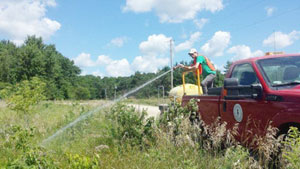

- Cover plants sprayed with insecticides and pesticides plus#
- Cover plants sprayed with insecticides and pesticides free#
Neem includes a buffet of chemicals that impact insects, including the most common active ingredient, azadirachtin. Neem and neem oil products are made from the seeds of the neem tree ( Azadirachta indica), native to Southeast Asia.

When used on roses, neem oil provides protection from black spot and aphids Best Uses for Neem That said, because of pyrethrin’s ability to knock down pests quickly, it can be useful for treating colonies of hugely invasive insects such as spotted lanternfly or brown marmorated stink bug larvae, or for Japanese beetles that cannot be reached for gathering by hand. Pyrethrins are simply too potent for everyday use in a garden that includes vegetables and flowers. Pyrethrin is sold as Bonide Pyrethrin Garden Insect Spray, Safer Tomato and Vegetable Insect Killer, and Japanese Beetle Killer, among other products.Ĭertified organic growers in the US are allowed to use pyrethrins only as a last resort, and the same standard should apply in the garden. Sunlight neutralizes pyrethrins within a few hours. Most insects quickly die after being sprayed with pyrethrins, so it’s important to avoid unwanted casualties among beneficials by covering treated plants with row cover or tulle for a day after pyrethrins are used. While pyrethrins are considered non-toxic to mammals, they cause immediate convulsions among insects upon contact. Organic pyrethrin products are made from the flowers of Chrysanthemum cinerariifolium, commonly known as Dalmation daisy. Use tulle to exclude bees and other beneficials from plants treated with pyrethrins and other organic pesticides Potent Pyrethrins After spraying, I cover the plants with row cover or tulle (wedding net) for a couple of days to exclude yellow jacket wasps, the only beneficials likely to visit the plants.

Cover plants sprayed with insecticides and pesticides free#
Spraying every 10 days keeps these veggies free of these persistent pests. Spinosad is the only organic pesticide I keep on hand, and I use it exclusively to keep cabbageworms and armyworms from taking over my fall broccoli, cabbage, and kale.

Spinosad is sold as Entrust, Tracer, or Monterey Garden Insect Spray. Ingestion of spinosad by leaf-eating pests causes paralysis and death. Spinosad has a negligible effect on honeybees and other pollinators, because it is most potent when eaten by the target pest, and bees don’t eat leaves.
Cover plants sprayed with insecticides and pesticides plus#
While Bt is great for cabbage worms, tomato hornworms, and other caterpillars, spinosad controls these pests plus most leaf-eating beetles, including flea beetles, Colorado potato beetles, and Mexican bean beetles. Made from a soil-dwelling bacterium, spinosad has largely displaced its close cousin, Bacillus thuringiensis (Bt), because spinosad controls a longer list of leaf-eating pests. Spinosad controls most leaf-eating garden pests found in the garden, including Mexican bean beetle adults and larvae What is Spinosad? I am also adding homemade hot pepper sprays to the list, though these and other aroma-based sprays are best used preventatively, as deterrents, and have limited value for insect emergencies. It is not a complicated process, because there are only a few choices among organic pesticides with clear records of success: Spinosad, pyrethrin, and neem. But pesticides are potent, so it’s important to choose the right active ingredient for the pest in question, and take steps to avoid unwanted casualties among beneficial insects. While natural pest control measures should always be your first port of call, organic pesticides can be used as a last resort.


 0 kommentar(er)
0 kommentar(er)
